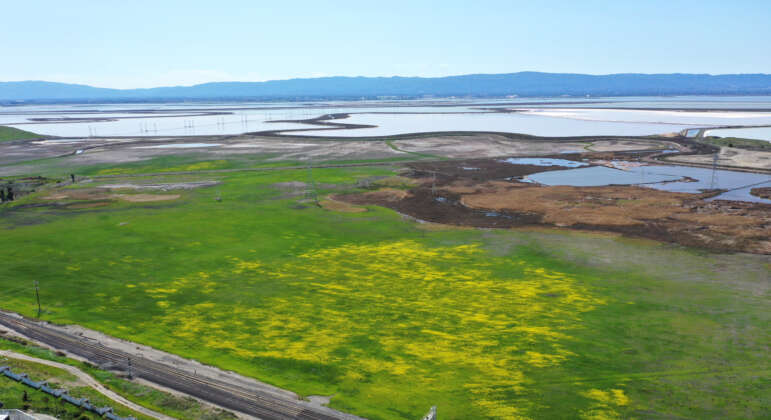10 Reasons to Protect and Restore Newark Area 4

Restoring San Francisco Bay – Over the past century, approximately 90% of San Francisco Bay’s tidal wetlands have been filled or diked off for development and other purposes. In order to restore the health of the Bay, over 100 scientists in 1999 established a regional goal of protecting and restoring 100,000 acres of wetlands around the Bay. As one of the largest remaining unprotected baylands in the South Bay, Area 4’s approximately 500 acres would make a significant contribution towards this important regional goal, and the overall health of our Bay.
Protecting Biodiversity – Wetlands act as the nurseries for the Bay, providing habitat to hundreds of fish and wildlife species and playing an integral role forming the base of marine and terrestrial food webs. In fact, wetlands are one of the most biodiverse habitats on the planet. Area 4 provides an important opportunity for California and the U.S. to achieve our “30×30” goal of conserving 30% of our lands and waters by 2030.
Increasing Access to Nature for Diverse Communities – For many decades, much of the Newark shoreline has been closed off to the public, depriving this Bay-side community of access to natural open space. A diverse community made up of 75% people of color and over 35% immigrants, protecting Newark Area 4 will not only allow the reconnection of Newark’s community with the Bay, but also provide highly-accessible outdoor recreational opportunities for local residents (see community map).
Providing Habitat for Endangered Species – San Francisco Bay’s wetlands are home to over a dozen endangered species, including two that can only be found in San Francisco Bay: the thumb-sized salt marsh harvest mouse, and the shorebird known as the Ridgeway Rail. The salt marsh harvest mouse has been recorded in Newark Area 4’s wetlands – and Area 4 has been identified as a valuable restoration opportunity by the U.S. Fish and Wildlife Service’s Tidal Marsh Recovery Plan to support the long-term survival of both species.
Protecting Existing Wetlands – Newark Area 4 contains several hundred acres of existing wetlands that are home to dozens of wildlife species. Developers’ proposals to build on nearly all of the higher elevation areas surrounding these wetlands would fragment and threaten these existing wetlands with pollution, disturb wildlife, and prevent the movement of wetlands and wildlife inland as sea levels rise.
Providing a Valuable Natural Flood Buffer for Sea Level Rise – As historic baylands, almost entirely within a 100-Year FEMA flood zone, Area 4 currently provides an important flood buffer to the City of Newark, and has been identified by climate experts, including the SF Bay Shoreline Adaptation Atlas, as a key opportunity for nature-based adaptation to sea level rise, acting as a sponge to capture flood waters — before they reach our neighborhoods and businesses.
Supporting the Resilience of SF Bay Wetlands to Climate Change – As sea levels rise, San Francisco Bay’s wetlands will need locations where they can migrate upland. Area 4 is one of the few large places in the South San Francisco Bay with significant space to support wetlands, and all the wildlife that depend on them, as they move to higher ground.
Helping Fight Climate Change by Sequestering Carbon – Coastal wetlands have been demonstrated to be one of nature’s most potent sources of “blue carbon,” acting quicker and better at trapping organic carbon than forests and delaying carbon increases for longer – providing an important natural tool for combating climate change.
Providing Stopping Grounds for Migratory Shorebirds and Waterfowl – San Francisco Bay is a critical stopover point along the Pacific Flyway migration route of shorebirds and waterfowl, with over one million birds visiting the Bay at the height of migration- making the Bay a site of “Hemispheric Importance” to migratory waterbirds. Area 4’s existing wetlands provide significant habitat for these migratory birds- habitat that would further be expanded if the full site is protected and restored.
Expanding the Don Edwards SF Bay National Wildlife Refuge – Newark Area 4 is within the authorized expansion boundary of the Don Edward SF Bay National Wildlife Refuge, the first urban wildlife refuge established in the U.S., and has been identified by the agency as a priority to protect wetlands, support the biodiversity of the Refuge, and increase the Refuge’s connections to local communities.

